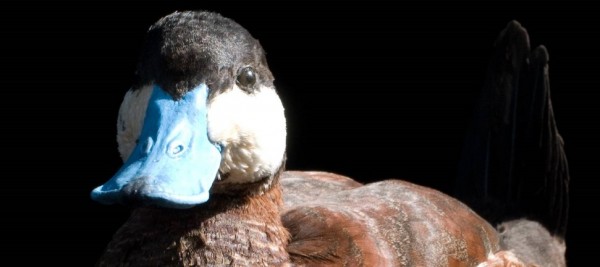Background
Ruddy Ducks Oxyura jamaicensis are a North American species which were imported into wildfowl collections in the United Kingdom in the 1950s. Some birds escaped from these collections and formed a free-flying population which expanded to cover most suitable habitat in the UK by 2001, when the population numbered around 6,000. As the British population expanded the number of Ruddy Ducks being reported from neighbouring countries increased and viable populations became established in France, Belgium and the Netherlands. Numbers of Ruddy Ducks also began arriving in Spain from the late 1980s and in the early 1990s these started to hybridise with the globally threatened White-headed Duck Oxyura cabeciblanca.

The West European population of this closely-related species is around 2,000 birds, all of which are found in Spain. This has grown from only 22 individuals in the 1970s because of a determined and costly effort by the Spanish Government and conservationists. It is illegal to hunt White-headed Ducks in Spain, and their main breeding and wintering grounds are Natura 2000 sites, protected under European legislation. As a result, hybridization with the non-native Ruddy Duck is generally agreed to be the greatest threat to the survival of the White-headed Duck as a separate species.
Management
In the mid-1990s the UK Government recognized the threat posed by the Ruddy Duck and funded three periods of research into control methods to determine whether eradication was feasible and which method would be most effective. Egg oiling, nest trapping, trapping and shooting were all tested and it was determined that it would be possible to eradicate Ruddy Ducks from the UK and that shooting was the most effective method. The decision to eradicate Ruddy Ducks from the UK in recognition of the risk they posed to the survival of the White-headed Duck was widely supported by conservation NGOs including the Wildlife Trusts, Wildfowl & Wetlands Trust, and RSPB. Following the extensive research the EU LIFE-Nature programme agreed to jointly fund a UK-wide eradication programme which started in 2005 and ended in 2011. During this period control of Ruddy Ducks took place on over 140 sites across England, Scotland and Wales, all with the voluntary agreement of the landowner. As a result the population fell from around 4,000 birds in 2005 to around 100 in 2011.
Since the end of the LIFE-Nature project Defra has continued to finance ongoing control and numbers across the UK have fallen to around 14 birds. These are widely scattered across the country and it is likely that the Ruddy Duck is now extinct as a breeding bird in Northern Ireland, Wales, Scotland. The best evidence available is that two or three breeding pairs remain in England and efforts continue to eradicate these.
European cooperation
There has also been significant progress in Europe in removing the Ruddy Duck populations in Netherlands, France and Belgium. The population in the Netherlands has been stable at around 100 birds for several years but the Dutch Government is now intensifying efforts to eradicate the species. Control of Ruddy Ducks has been ongoing in Belgium for several years and has reduced the population to single figures. Each year the Belgian authorities monitor sites in order to prevent breeding and the few birds that are seen are believed to have come across the nearby border with the Netherlands. In France another LIFE-Nature funded programme began in 2018 which has seen numbers fall from an estimated 160 at the start of the project to fewer than 20 in spring 2021. This programme is due to end in autumn 2024 by which point it is hoped the Ruddy Duck will have been effectively eradicated in France.
